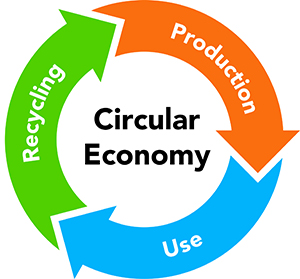The Circular Economy in Construction
05 November 2021
05 November 2021
 A circular economy (sometimes referred to as circularity) is a model of production and consumption, which involves sharing, reusing, repairing, refurbishing and recycling existing materials and products for as long as possible. The principle aim of the circular economy is to help tackle global challenges, such as climate changes, biodiversity loss, waste and pollution.
A circular economy (sometimes referred to as circularity) is a model of production and consumption, which involves sharing, reusing, repairing, refurbishing and recycling existing materials and products for as long as possible. The principle aim of the circular economy is to help tackle global challenges, such as climate changes, biodiversity loss, waste and pollution.
In a circular economy, manufacturers design products to be reusable. For example, electrical devices are designed in such a way that they are easier to repair. Products and raw materials are also reused as much as possible. For example, by recycling plastic into pellets for making new plastic products.
A linear economy traditionally follows the take-make-dispose process. Essentially, raw materials are collected, and then transformed into products that are used until they are finally discarded, when no longer required or at the end of its useful life, as waste.
As the illustration below shows, the reuse economy keeps valuable resources in circulation to lower the impact on the environment. The aim is to use a product over and over again, and therefore to extract the maximum benefit from it, before breaking it down to its constituent parts and recycling it. It is the transition stage from linear to circular.

The construction industry is one of the world’s largest consumers of energy and raw materials. Fact. And, this is taking its toll on the environment. In the EU, construction is responsible for circa 40% of CO2 emissions and a third of all waste. Moving from a linear to a circular economy would therefore yield huge ecological improvements. There are also considerable economic advantages, world-wide the opportunity is thought to be several trillion dollars per year.
For the construction industry the transition is about considering how to maximise the lifespan and reusability of an entire building and/or materials at the very start of the design process.
In RIBA’s publication Building Revolution they have set out their circular economy design principles;
World-wide we need to move away from the recent trend for stripping out buildings every few years and tearing them down well short of the end of their design life. New buildings are constructed from components made from hard-won virgin materials with virtually no reuse or reclamation. It is estimated that the global built environment demands around 40 percent of the world’s extracted materials. Plus, demolition waste is the largest waste stream in many countries. This is clearly highly wasteful, and with little thought given for the future.
Applying circular economy principles to buildings uses fewer resources, enables adaptation for different uses and can even provide healthier environments for people to live and work in. They also create an opportunity to design buildings that are not simply consumable goods, leaving a positive legacy for future generations.